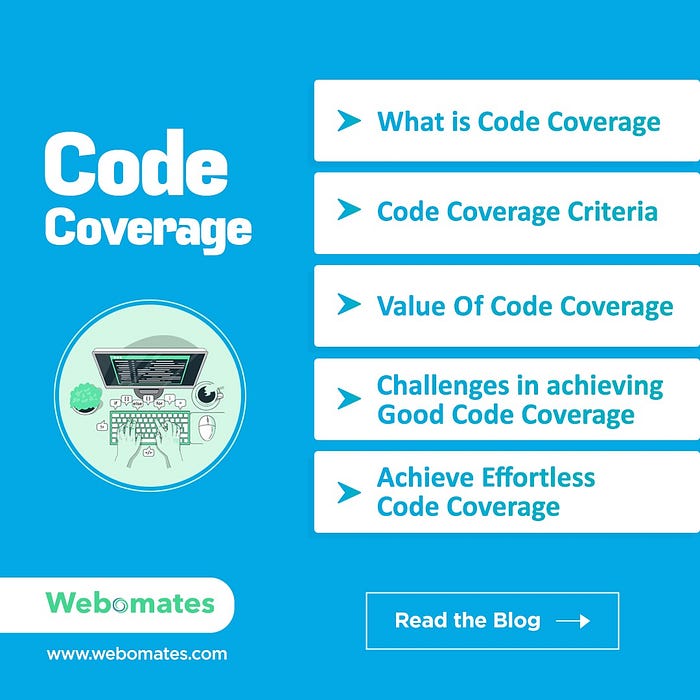Code coverage criteria is software testing metric that determines the number of lines of code that is validated during a test procedure, which in turn helps in analyzing how comprehensively a software product has been verified. In short, it allows organizations to evaluate their code to identify its

Photo of Code coverage criteria | Achieve Effortless Code Coverage by Webomates Inc Software testing assesses application quality. Do we need to assess testing quality as well? Yes, the test strategy, assets, and practice have distinct quality aspects. Some of the aspects that we can examine the testing quality are listed below:
Testing Scope: The depth and breadth of the application areas covered and test scenarios covered.
Relevance: Significance of the areas covered during testing and the defects found.
Efficiency: Result and test output in terms of defects as per the time spent.
Efficacy: Defects found per test effort (creation, maintenance, execution, analysis).
Drag: The time spent holding a release while it is being tested, non-tester time invested in test asset creation and review.
Reporting and Analysis: Clarity of defect reports, meaningful analysis.
This article focuses specifically on the quality of application scope. The methods we can use to assess scope are threefold:
Requirements traceability: Mapping of application features, functions, use cases, and or/scenarios to test cases.
Test artifact review: Manual review of test suites, test cases, test data, and applied judgment.
Code coverage: Automated assessment of application coverage.
These three methods are complementary and should be used together.
Code coverage has the advantage of being objective since it is provided by a computer and cannot be disputed or subject to opinion. Furthermore, the heavy lifting is done by the computer, although a little labor is required to set it up using the tools available.
So code coverage is an important mechanism for assessing one aspect of test quality. It provides several types of quantitative metrics at various application code hierarchies, as well as qualitative data — displays of annotated source code, showing lines exercised and not exercised.
What is Code Coverage
In simpler words, “Code coverage is software metrics for the number of lines, branches, and conditions of code exercised during the execution of your test suite.”
Any line of code that has not been validated is potentially a ticking time bomb waiting to go off. In a way, code coverage is a preemptive measure to find issues before the code goes to production. Additionally, code coverage is extremely vital for understanding parts of the code that are rarely executed, such as code for handling exceptional and atypical scenarios.
Good Code coverage is the result of well-defined QA Ops practices and is your safety net that prevents disasters. Inculcating good design, execution, and quality process from the onset is the way to go.
There are multiple criteria used by developers and test engineers to ascertain the code coverage criteria. The most commonly used are listed below.
Function coverage: The number of functions that have been called.
Statement coverage: The number of statements that have been executed.
Branches coverage: The number of the branches of the control structures, like if-then, that have been executed.
Condition coverage: The number of Boolean sub-expression tested for a true and a false value.
Line coverage: The number of lines of source code that have been tested.
Besides these, depending on the type of product Finite State Machine coverage, transition coverage, register toggle coverage, etc. are also considered while calculating code coverage.
Value of Code Coverage
Code related
Identifies bad and dead code: Code coverage analysis points out unused legacy code which can be removed to keep the code clean. It also helps in improving coding practices by pointing out loopholes.
Helps in identifying code segment omissions: Code coverage helps in identifying the code segments which may not be executed just because the conditions were not “right”. It is imperative to test every segment to improve the quality to prevent any surprise bugs.
Test related
Early defect detection and prevention: Early defect prevention helps in managing your technical debt better. We have covered test analytics and its value in detail in our blog “Intelligent Analytics with AI-based test automation”. Read it to understand how defects discovered late in the project life cycle can create havoc.
Helps in identifying test omissions: Code coverage aids in creating new test cases to increase coverage by identifying untested code segments.
Gives a quantitative measure of code coverage: Quantitative measure of code coverage is a number that raises a red flag if not in line with the set target. It sets the wheels of analysis and damage control in motion.
Measures efficacy of test suite: Code coverage helps in analyzing how comprehensively a software is verified and how well the test suite was designed to cover all possible test scenarios. Click to know more about this article: Code coverage criteria

